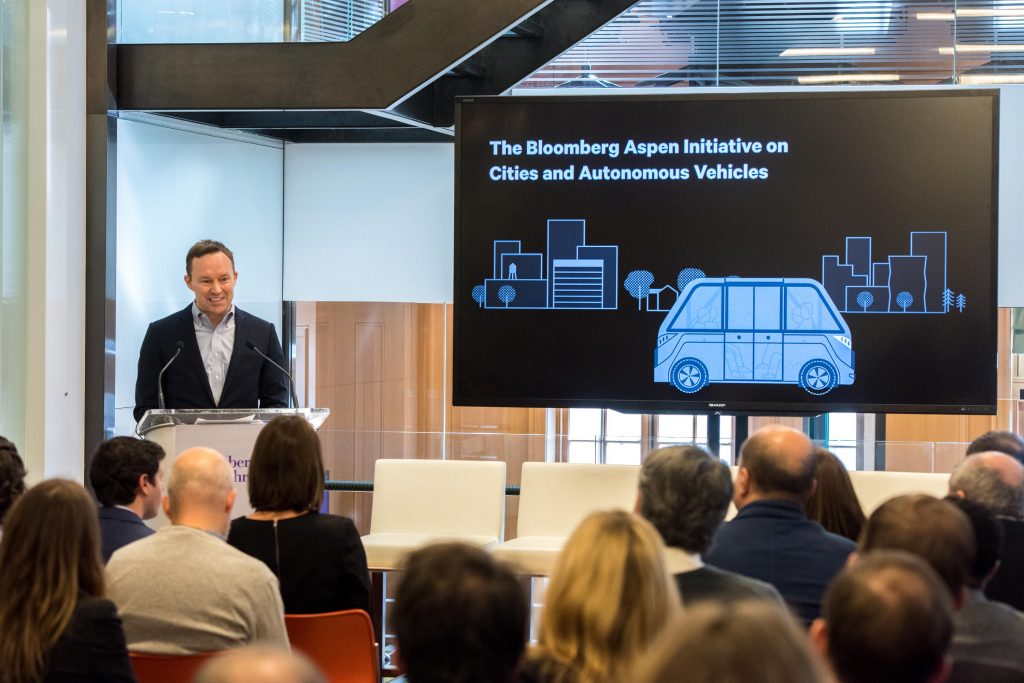Autonomous Vehicles: Putting Cities in the Driver’s Seat

By James Anderson, Government Innovation at Bloomberg Philanthropies
Bloomberg Philanthropies and the Aspen Institute just concluded two inspiring days of discussion on cities and the transition to autonomous vehicles – a reality that’s no longer in the distant future. This convening, which brought together city officials with leading voices from the auto industry, tech and innovation sectors, social justice organizations, and academia, was the first major step of the Bloomberg Aspen Initiative on Cities and Autonomous Vehicles. Through this year-long effort, we’ll work with 10 leading cities to help accelerate and strengthen their efforts to prepare for the challenges ahead, while also sharing what we learn with a broader community of cities across the globe. Our work is just starting, but I came away from our conversations with five key insights.
-
Cities need to move first.
With many cities still licking their wounds after bruising battles with Uber and other new-economy companies, one key lesson has emerged: Cities must get “out in front” of the shift to AVs with a compelling, values-based vision for their future. Cities need – and citizens deserve – a bold, proactive vision for how this new technology can improve lives. What’s at stake if cities wait? A lot. They could lose control of their streets, see critical revenue disappear, or miss essential opportunities to help workers whose jobs will be impacted by automation come out ahead.
-
Lead with problems, not technology.
Our obsession with the shiny and new can lead us astray. That’s why cities should step into this new world by focusing not on what technologies they want to buy, but what problems they want to solve. If cities lead with problems, the brightest minds in industry and technology can follow with meaningful solutions. That’s the best way to ensure the AV revolution helps cities solve things that matter most to residents – whether that’s reducing vehicle miles traveled, improving air quality, or connecting at-risk communities to economic opportunity.
-
Put people at the center.
Residents have the biggest stake in this AV future. And local policy makers have an important opportunity to engage with them to understand their needs, solicit ideas, and design and test new solutions. Methods like human centered design, which over the last few years has begun taking root in governments worldwide, can be especially powerful. If they engage residents in the creative process, city halls can develop strategies and solutions that really work in people’s lives.
-
Cut across silos.
At first look, AVs are about transportation and the way people and goods move in urban areas. But in the same way smartphones are about so much more than talking to another person, AVs will impact more than just the way we drive. They’ll affect how we use land, how and where local economies will grow, and how we contend with issues of equity, race, and social cohesion. Transportation chiefs will stand center stage in facilitating this revolution, to be sure, but mayors must be mindful that the implications here are far broader. Cross-agency working groups are one smart way to go.
-
Work together.
Cities are accustomed to working together to address urgent challenges like climate change. Here, they can combine efforts to shape an entire emerging market – something much less possible if each city acts on its own. This may take the form of setting data sharing standards or partnership principles for AV companies looking to test and scale up on city streets. Many of the cities we’ve talked to are hugely interested in exploring these possibilities; they know from experience that cities are stronger when working together.

City leaders from the U.S., Brazil, and Argentina, alongside city and design experts from Europe, discuss how cities can prepare for the arrival of autonomous vehicles
Autonomous vehicles have the potential to reshape cities in ways we’re just beginning to understand. But this much is clear: If we work together, and learn from each other, we’ll be able to equip cities with the information they need so that in the AV revolution, people come first.